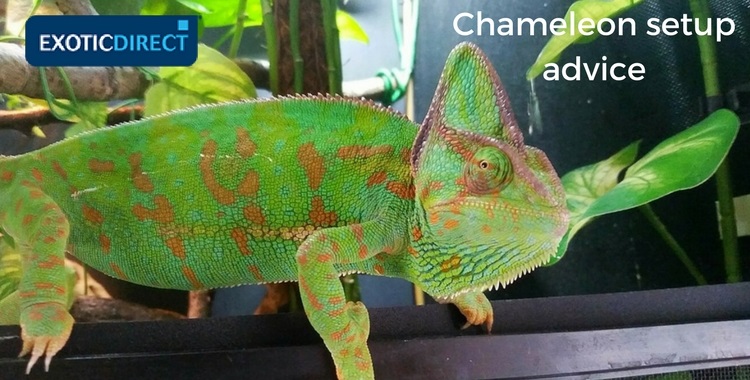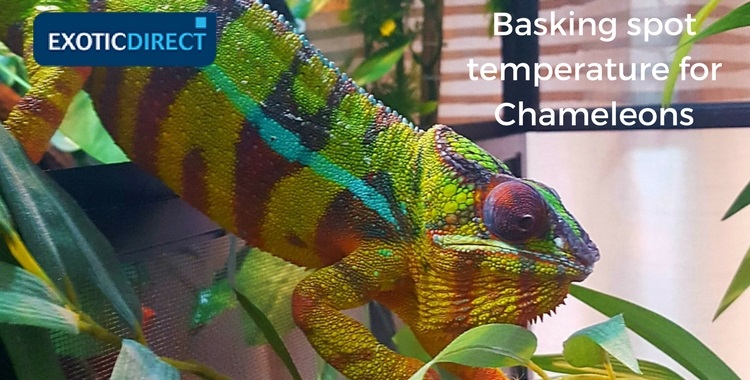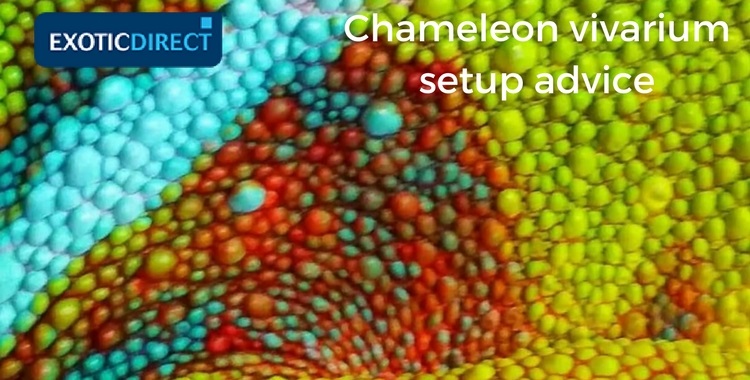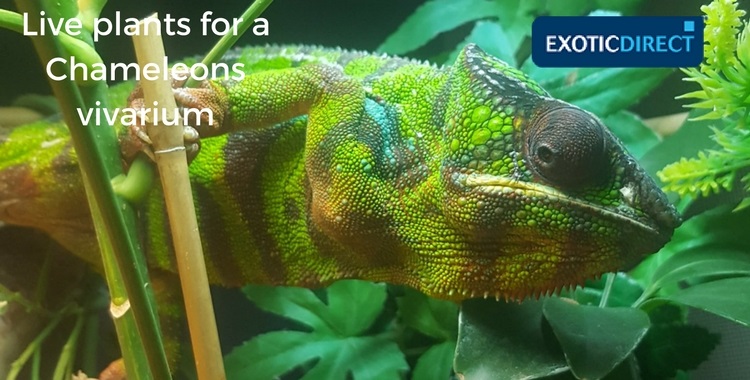Having been a Chameleon keeper, on and off for over two decades (Reptiles and Amphibians in general, for over 30 years), much has changed in our Chameleon set-up’s when I look back and compare then, to now.
Is your chameleon insured? Get a quote for £1,000 of vet fees, death and theft cover. Vet fee cover only also available | We’ve been insuring exotic pets since 1996 | Check out our customer reviews on Feefo.
Click link to skip to topic: What size tank does a Chameleon need? | Chameleon heating | What types of bulbs are needed for Chameleons? | Basking spot temperature for a Chameleon | What do Chameleons drink out of? | Humidity levels for Chameleons | Do Chameleons need heat lamps at night? | Chameleon lighting and UVB | Using UVB bulbs for Chameleons | Live plants for a Chameleons vivarium | Branches for a Chameleons vivarium | How often should I clean the vivarium?
So the Chameleon set up advice below is based on my experiences. And honestly, it works for me.
What size tank does a Chameleon need?
Ideally, the XL Zoo-Med Reptibreeze cage or at ‘least’ the medium Arboreal Vivexotic Viva+ Medium wooden vivaria will be ideal for one adult (do not house them together).
Many like to start their young Chameleons in smaller setups. This is fine – something like the Vivexotic Arboreal small or small/Med Reptibreeze is ideal.
But I have found if you have lots of coverage, foliage, UV and heat options a young Chameleon does perfectly fine in a large setup from the get-go.
 You should have lots of foilage, UV and basking options for your Chameleon
You should have lots of foilage, UV and basking options for your Chameleon
Chameleon Heating
Create your Chameleon, a basking zone. Not just one branch under the basking bulb, but provide several horizontal and vertical options in that area.
This gives your Chameleon far more choice on the temperature it wants to bask at. Much like in wild conditions where they would use different levels of branch.
Also use foliage so that your Chameleon can seek less heat and UVB exposure.
For me, I see best naturalistic activity when a nice bright white bulb is used, although I am currently using one of the new Arcadia Deep Heat Projector bulbs on my female Veiled Chameleon.
This provides no light, but infrared A & B wavelengths. And so far, after a month or so it’s going amazingly well.
And I do prefer my heat bulbs setup on the outside of the setup. So, on-top of the mesh – this is a much safer option.
Of course, if you can’t do this then please make sure you use a bulb cage for protection within the setup.
It’s also important to make sure the Chameleon cannot get near, or climb that protective cage.
Check out Corn snake set up advice also written by Pete Hawkins.
What types of bulbs are needed for Chameleons?
The size (wattage) of bulb needed here will vary, depending on a few factors.
- Your own geographical location temperature
- Room temperature
- Setup location (near window, etc)
- Setup size
All these play a huge part on the bulb and wattage needed for your setup.
I’d suggest getting a few different wattages. See what reaches the needed temperature best as it will ultimately be controlled by the thermostat anyway.
Also, always run your heat-source through a thermostat. A dimming thermostat is needed for a light emitting heat-source.
I personally use the Microclimate Evo’s but there are many options available. As long as it’s a dimming stat.
 Veiled and Panther Chameleons bask at different temperatures
Veiled and Panther Chameleons bask at different temperatures
Basking spot temperature for a Chameleon
Here are the vivarium temperatures I’d aim for in your Chameleons vivarium (using a digital thermometer at basking). Higher temperatures could lead to issues:
- Veiled Adult (1 year +) – 31c-35c (87f-95f)
- Veiled Young (under 1 year) – a little cooler. Around 29c/30c (84f-86f)
- Panther Adult (1 year +)– 29c-30c (84f-86f)
- Panther Young (under 1 year) 27c-28c (80f-82f)
And again please make sure your Chameleon, no matter which sub-species, does not get near or climb up to the heat or UVB.
This will cause problems including thermal burns, PKC (Photo-kerato-conjunctivitis) and severe dehydration.
Own a Bearded Dragon? Check out what you should be feeding your beardie…
What do Chameleons drink out of?
Chameleons drink by licking the water droplets off leaves. You can use a plant dripper or misting to provide the water droplets.
Plant drippers: Mine love the Exo-Terra plant dripper.
I have this placed inside a tub, with a section of the lid cut out, and holes drilled into the lid to allow me to place it around the stem.
This allows the pump and water to be protected, and water to drip back in, creating a clean cycle. Away from bugs, faeces and dirt.
I have also used in the past, the Zoo-Med Big dripper on top of my set-ups.
This is a simple tub or water that drips at your set rate via the little tap. It then drips onto leaves within the setup.
Misting System, manual spraying: This is a must for Chameleon keepers. Of course if you are home most of the day you can do this manually.
But there will be times where you are away, and an automatic misting system will be your saviour.
I’ve used most brands over the years, and for me the Mist-King and Exo-Terra Monsoon systems are the best.
It’s a case of setting up the spray nozzles in the setup, setting up the timer and away you go.
Misting your Chameleon setup will be a huge hydration option. Covering all those plants with a good soaking of water allows your Cham to drink off the leaves. So its a good thing.
Try not to spray your Chameleon directly. Many get stressed over this and stress with any species is never a good thing.
It’s also worth mentioning….use warm water. This is far more comfortable for the Chameleon if it does get wet. And, evaporates better, thus causing humidity spikes in the setup. Again, this is a good thing.
I also use aquarium heaters inside my Mist-king reservoir. Set it at a toasty 30C and when it comes out the nozzles, it’s a nice warm mid 20C temperature, and they love this.
Unfortunately hydration is the big Chameleon killer and is still a huge issue among Chameleon keepers. This is also something I covered in an article in ‘Practical Reptile Keeping’ magazine back in 2016.
The best way to combat such issue, is to supply as many hydration methods as possible.
 Beautiful Chameleon colours
Beautiful Chameleon colours
Humidity level for Chameleons
I aim for around 40%-60% with my Panther Chameleon’s and keep the humidity level up by spraying it. I then let the setup up completely dry out before misting the setup again.
What you want is humidity spikes. Staying low is almost as bad as it being constantly high. So please allow the setup to dry out before spraying again if needed.
The humidity level is exactly the same for a Veiled (Yemen) Chameleon really regarding the spikes and letting the setup dry out.
Although I do not spray as much with them.
They are naturally from a much drier geographical location. So a couple of mistings a day works for most.
For a Veiled Chameleon, as long as the hydration options are there all should be great even if it does drop below 40% due to spraying slightly less.
Humidity is a huge part of a Chameleon’s well being, and I use digital hydrometers in my setups to read such as well as the readings on my Microclimate Evo Pro thermostats.
Do Chameleons need heat lamps at night?
In all the years I’ve kept reptiles, I’ve not used overnight heating on many of my lizard species (Dragons. Chameleons. Skinks. Monitors for example). And this is so with Chameleons.
You could easily go down to 10C (50F) within that setup before even considering the need for additional heat.
And honestly, whose house gets that cold before they put their own central heating system on, thus warming up the house, and the reptile setups with it? No-one would go this low.
The temperature drop is actually very beneficial to them. Think about it. If you have a Ceramic bulb running at night keeping those temperatures up, there is little reason for them to bask and energise in the mornings.
This ‘could’ lead to a reptile that is sleeping longer, eating less, doing less.
The drop gives their body the chance for proper thermoregulation, something they have being doing on an evolutionary level for millions of years. And doing it very well too, so don’t change this at home.
People panic way too much and have this deluded reality of “well I feel cold so the reptile must be cold”. Or “he/she feels so cold when I touch him/her”.
The reality is in-fact they are ‘cold-blooded’, unlike us humans who are warm blooded. So they would always feel cold to touch.
This is why they need that external heat-source to heat up and to energise (sun, basking bulb, UVB).
This gives them the charge up needed to go about their day hunting and climbing. This is why as soon as those basking lights and UVB tube comes on of a morning they climb up and bask. Fully exposing themselves to the heat and UV energy. Charging up, so to speak.
Heat source for Chameleons at night
If you do require a night heat source, then the best option is a CHE (Ceramic bulb). These provide zero light and only heat. So it will not disturb the Chameleons sleep as a night light would.
And the same safety precautions here, protective cage and thermostat.
And keep a nice steady 16C – 18C (60F- 64F) for the twelve hours you have the lights off.
Chameleon lighting and UVB
Getting the right UVB is vital, it is a captive reptiles lifeline. Without this, or by using below par, inadequate UVB, like coil UVB, your Chameleon will more likely have health problems along the line.
So get this UVB lighting correct from day zero, before you have that Chameleon.
-
- On top of Mesh set ups: For both Veiled and Panther Chameleons I use Arcadia T5 12% UVB, with a reflector.
One being the linear 12% tube, the other, the Arcadia Flood.
This essentially filters the UVB down to the required, more naturalistic UV-Index to which they are more accustomed too.
-
- Inside a set up: To obtain this using the UVB tube ‘inside’ a setup. I’d recommend using the Arcadia T5 6%, with reflector.
I use a tube size that runs the width of the enclosure, or at least three quarters of the width.
And all UVB must be mounted directly overhead. I’ve seen many incorrectly mount their UVB half way down a setup wall or even running downwards.
The natural UV needs for a Chameleon
The ‘average’ UV index of Yemen, where our Veiled chameleons originate from, is between 3 and 7.
With peaks of 10+ depending on times of year and the area of Yemen it recorded.
These levels are recorded in the open not in the shelter of a tree canopy.
This is much the same for Madagascar, where our Panther Chameleons are native. Again, this can peak even up to 10+ depending on locality and time of year.
Using UVB bulbs for Chameleons
The basking spot temperature for both my Veiled (Yemen) and Panther Chameleons is about 2.5 and 3.
If on mesh, use the 12% T5, with reflector, on the outside, at around 13 inches from the Chams back.
If inside a setup, use the T5 6% with reflector, again around 13 inches.
This is how I set up the UV for my Chameleons to achieve the best basking spot temperature:
With my Solar-meter 6.5 in hand (this measures the UV index) I setup my enclosures first starting with an index at basking spot of around 5.
I found after a few days they were basking far lower in the setup. And according to the solar-meter, at indexes around 2.5 to 3 midway in the setup.
So I adjusted this to suit the maximum it would reach, at the basking spot.
So now it’s between 2.5 and 3, for both the Veiled and Panther Chameleon.
And this is actually is pretty much the recommended distance as per the packaging instructions of the Arcadia T5 12% tube. 13 inches from the tube, to Chameleons back at the basking spot.
And this does seem to be the ‘sweet spot’ as they say.
I see regular intense basking sessions by the Chameleons, taking in maximum heat and UV exposure at the main basking zone.
More so, first thing in the morning, and after food. Followed by a more selective routine of lesser exposed areas of basking within the setup throughout the day (lower in the enclosure or under foliage cover. Or of course, climbing around).
So I’ve stuck to this method and distance, for both species.
And with blood tests and faecal tests showing everything is good and levels are great, these are the index’s I have aimed for since.
Now, I’m fully aware not everyone has a solar-meter to test these things so my best advice is:
Follow the tube manufacturers guides. Arcadia for example recommend a T5 UVB tube is around 13 inches from tube, to reptiles back. This is a really good guide as explained above.
And if you have your setup as already mentioned, with plenty of levels of exposure within, the Chameleon can choose its own exposure. This IS the best way to do things.
So to repeat here with the UVB – if on mesh, use the 12% T5 with reflector, on the outside, at around 13 inches from the Chams back.
If inside a setup, use the T5 6% with reflector, again around 13 inches.
 Chameleons like natural vegetation.
Chameleons like natural vegetation.
Live plants for a Chameleons vivarium
I have used and tried so many over the years, and I have come to rely on a handful that just seem to thrive in the Chameleon setup conditions.
These are:
- Ficus benjamina (weeping fig)
- Pothos (Devils Ivy)
- Umbrella Plant
- Dracaena
- Yucca
For me, you just can’t beat using real plants and branches in a setup, and for my Chameleons this is definitely the case.
It’s also well worth using a plant growth light. For me personally, after trying many over the ears the Arcadia Jungle Dawn has me seeing actual results.
It’s also well worth using a plant growth light. For me personally, after trying many over the ears the Arcadia Jungle Dawn has me seeing actual results.
These are a LED lighting system fully designed to replicate sunlight. They run at 6.5-7 kelvin which is the sweet-spot for plant and flower growth.
I have the 13w version in many of my setups sitting on top of the mesh is fine for these also.
Of course you can use fake foliage in setup or a mixture of both. But do stick to reptile branded ones.
I’ve seen many keepers use ones from high-street shops. These are not tested within our setup conditions like the reptile branded one’s.
So it’s safer to use what you know is not a fire or swallowing risk.
Branches for a Chameleons vivarium
I tend to stick to Oak, Birch and Willow branches. And always what I find on the floor. Please don’t take branches off trees.
You CAN use pine, only if it’s an old branch as it’s the sap within these branches that can be an issue but on older branches it’s all dried out. But it’s just safer to stay away from these.
There is no need to bake the branches, unless you intend on eating them…..
Same goes for bleaching, freezing, lasers, Jedi mind-tricks. None of that nonsense is needed.
There is nothing on that log that can harm our Chameleons. No mites or bugs are going to jump out and eat them. You only have to look on my Facebook Chameleon group (Chameleon Network) to see the science and proof of such.
As for where I find them – I collect my branches while out for walk with the dog.
As long as you collect away from roads (you don’t want pollution tainted branches) and in pesticide free areas, you are good to go.
For fake branches I would recommend using the fake bendy vines you can get from the likes of Northampton Reptile Centre.
These add that extra element of filling out the enclosure. More climbing options for the Cham too. And they do look great.
How often should I clean my Chameleons vivarium?
This is all based on what substrate you have decided to use for your Chameleon. For me, I use both bioactive substrate (a living eco system) and bare floor.
In short, bioactive substrates are the use of soil, live bugs such as woodlice. mealworms. springtails, to keep the soil alive. The live bugs also clean your vivarium by eating the waste and they aid plant and setup health.
So cleaning waste in these setups is not needed once its established.
If you don’t choose the bioactive method then I do suggest a bare floor.
You can find out more about bioactive substrates in the setup files in Chameleon Network.
A bare floor is the most hygienic method of cleaning your Chameleons vivarium after bioactive.
And it’s just a case of cleaning waste daily, or when it’s seen, with F10SC disinfectant or the handy ProRep Protect wipes.
The Pro-rep wipes are also safe to use on plant leaves, I’ve being using them for years to clean them as needed. Never had any issues at all.
In conclusion
You should think about the following when setting up your Chameleons vivarium:
Think big with the setups; keep your Chameleon hydrated; and try to keep it ‘real’ inside the setups. Give the Chameleon the ‘option’ to bask and be exposed to heat and UVB where it chooses.
Also provide multiple levels of climbing and shelter within foliage, this provides mental and physical enrichment.
Is your chameleon insured? Get a quote for £1,000 of vet fees, death and theft cover. Vet fee cover only also available | We’ve been insuring exotic pets since 1996 | Check out our customer reviews on Feefo.
Pete Hawkins is an administrator on a number of Facebook reptile groups such as the Chameleon Network, the Snake Network and the Bearded Dragon Network
Pete also writes for The Reptile Apartment and Practical Reptile Keeping.
Pete Hawkins may receive commission for pet insurance sales that result from you clicking on a link within this article.
Don’t miss out!
Sign up for our FREE monthly newsletter full of interesting content! And it’s spam free.
* indicates required field

